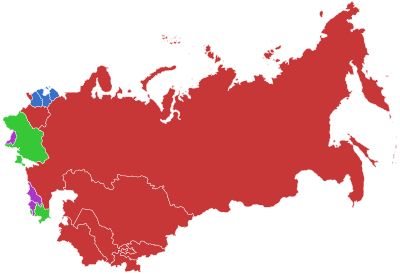- Union of Sovereign States
-
Union of Sovereign States (Russian: Сою́з Сувере́нных Госуда́рств [ССГ] Soyuz Suverennykh Gosudarstv [SSG]) was the proposed name of a reorganization of the Union of Soviet Socialist Republics into a new confederation body. Proposed by Mikhail Gorbachev, the proposal was an attempt to avert the collapse of the Soviet Union. The proposal was never implemented in the wake of the August Coup and the eventual dissolution of the Soviet Union in 1991. The overall proposal was resurrected as the Commonwealth of Independent States (CIS).
Contents
Development
The New Union Treaty (Russian: Новый союзный договор) was a draft treaty that would have replaced the 1922 Treaty on the Creation of the USSR and thus would have replaced the Soviet Union by a new entity named the Union of Sovereign States, an attempt of Mikhail Gorbachev to salvage and reform the Soviet state. A ceremony of the Russian SFSR signing the treaty was scheduled for 20 August 1991, but was prevented by the Soviet coup attempt of 1991 a day earlier. The preparation of this treaty was known as the Novo-Ogarevo process (новоогаревский процесс), named after Novo-Ogaryovo, a governmental estate where the work on the document was carried out and where Gorbachev talked with leaders of Union republics.
A less centralized federal system as a solution to the Soviet Union's increasing ethnic problems was proposed by President Gorbachev during the Communist Party Congress of July 1990. A draft of the New Union Treaty was submitted to the Supreme Soviet of the USSR on November 23, 1990. A drafting committee started work on the text on January 1, 1991. Six of the fifteen Soviet republics, however, did not participate in drafting of the treaty: Estonian SSR, Latvian SSR, Lithuanian SSR, Moldavian SSR, Georgian SSR and Armenian SSR. The proposal was approved by the Soviet of the Union on March 6 and sent to the Supreme Soviets of the republics for approval. Agreement could not be reached on the distribution of power between the Union and the Republics and the proposal was not approved. As an additional restrictive element, some autonomous republics expressed the desire to raise their status and to be a party to the new Soviet treaty.
President Gorbachev tried to gain popular support for the proposal. On March 17, 1991 a popular referendum was held in the nine republics (Russian SFSR, Ukrainian SSR, Byelorussian SSR, Kazakh SSR, Azerbaijan SSR, Uzbek SSR, Kyrgyz SSR, Turkmen SSR, and Tajik SSR) which participated in the drafting of the treaty. In the referendum 76% of voters supported maintaining the federal system of the Soviet Union, including a majority in all of the nine republics. Opposition was greatest in large cities like Leningrad and Moscow. The referendum was mostly boycotted in the other six republics already moving towards independence.
An agreement between the Soviet central government and the nine republics, the so-called "9+1" agreement, was finally signed in Novo-Ogaryovo on April 23. The New Union Treaty would have converted the Soviet Union into a federation of independent republics with a common president, foreign policy, and military.
By August, eight of the nine republics, except Ukraine, approved the draft of the new Treaty with some conditions. Ukraine did not agree on the terms of the Treaty. In the republican referendum on March 17, the majority of residents of Ukraine supported joining the Union on the terms of Declaration of State Sovereignty of Ukraine.
Though the treaty was intended to save the union, hardliners feared that it would encourage some of the smaller republics to follow the lead of Lithuania and press for full independence. After the dissolution of the Soviet Union in December, the leaders of republics organized the Commonwealth of Independent States, an alliance of 12 newly independent states (initially all ex-Soviet republics except the Baltic states and Georgia; Georgia joined in 1993, withdrew in 2008).
Names
On the first draft of the treaty released in July 1991, the proclaimed name for the new nation was the Union of Soviet Sovereign Republics (Russian: Союз Советских Cуверенных Республик Soyuz Sovyetskikh Suvyeryennykh Ryespublik).[1] This name was proposed in order to conserve the Russian "СССР" acronym, as well as the "USSR" and "Soviet Union" in English.
By November 1991, the overall support for preserving the Soviet state changed to reform the Soviet Union into a confederation of sovereign states. The final draft renamed the proposed state the Union of Sovereign States (Союз Суверенных Государств Soyuz Suvyeryennikh Gosudarstv).[2] The overall continuation of the Soviet Union continued to drop and was soon abandoned. Following the August coup, the new union treaty was further reformed into the Commonwealth of Independent States.
See also
References
- The USSR in 1991: The Implosion of a Superpower by Dr. Robert F. Miller, RSSS, ANU.
- 1991 Diplomatic Bluebook, Section 4. The Soviet Union by the Japanese Foreign Ministry.
- My Ambition was to Liquidate Communism Mikhail Gorbachev, interview with newspapers in Ankara, Turkey. "The liquidation of the USSR is not beneficial to the USA, since they have now no mighty democratic country (the former USSR) which I wanted to call the Union of Independent Sovereign Republics. I could not accomplish all of this."
Categories:- History of the Soviet Union and Soviet Russia
- 1991 in the Soviet Union
- Post-Soviet alliances
- Proposed treaties
- Dissolution of the Soviet Union
Wikimedia Foundation. 2010.

